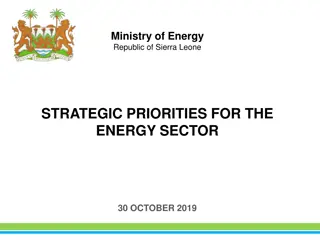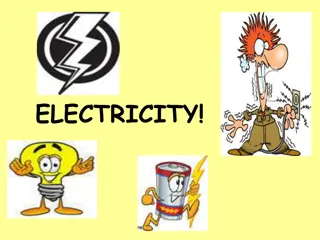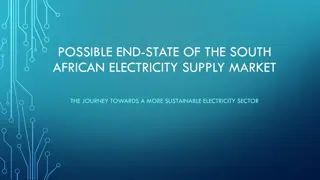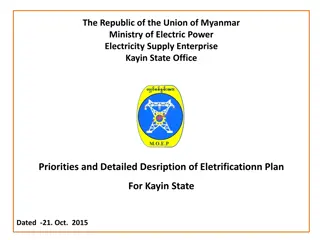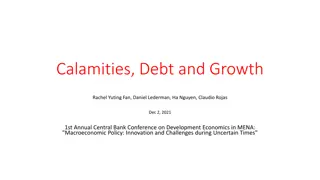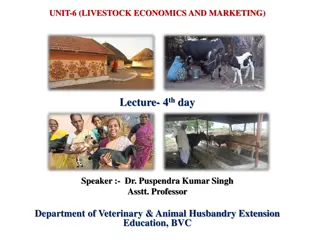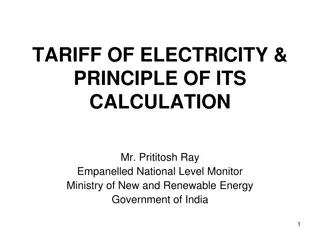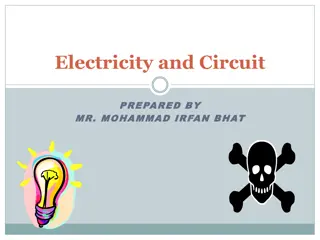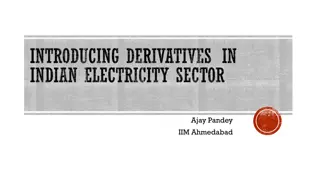Electricity Supply and Economic Growth in Developing Countries
Electricity supply plays a crucial role in economic growth in developing countries. While lack of access to electricity can hinder growth, some fast-growing economies have managed to grow despite poor access. Research analyzes the impact of electricity constraints on economic performance, highlighting the complexities of this issue.
Download Presentation

Please find below an Image/Link to download the presentation.
The content on the website is provided AS IS for your information and personal use only. It may not be sold, licensed, or shared on other websites without obtaining consent from the author. Download presentation by click this link. If you encounter any issues during the download, it is possible that the publisher has removed the file from their server.
E N D
Presentation Transcript
Is Electricity Supply a Binding Constraint to Economic Growth in developing countries? NEIL MCCULLOCH AND DALIA ZILEVICIUTE ENERGY AND ECONOMIC GROWTH RESEARCH PROGRAMME 3-4 NOVEMBER, WASHINGTON D.C.
The questions and the answers 1. Is electricity supply a binding constraint to economic growth in developing countries? 2. To what extent is electricity being a binding constraint reflected in high average electricity prices? The Answers 1. Yes! 2. Not much
Isnt it obvious? an estimated 1.2 billion people 17% of the global population did not have access to electricity in 2013 in 2015 firms in South Asia and Sub-Saharan Africa lost 10.9% and 8.8% of sales respectively due to electrical outages But Lack of access and unreliability could be a symptom of poor economic performance or of good economic performance Several of the world s fastest growing economies had very poor access, so lack of access doesn t seem to have stopped them from growing.
Systematic Review INCLUSION EXCLUSION 1. Hausmann OR Rodrik OR Velasco AND binding AND constraints AND growth Didn t use HRV methodology Not economy wide 2. Since 2004 Poor quality application of the method 3. Articles and studies published in English Numerous social science research databases, including EconLit, Social Science Research Network (SSRN), EBSCOhost, Google Scholar and Google search engines, institutional websites and databases and multilateral and bilateral international development organization websites. This yielded 55 studies which we reviewed. This initial search produced a list of 152 articles.
Evidence extracted QUESTIONS ASKED OF EACH PAPER DIFFERENTIAL DIAGNOSIS Are the shadow prices of electricity as a constraint high? Do movements in the electricity constraint produce significant movements in the objective function? Are agents in the economy attempting to overcome or bypass the electricity constraint? 1. To what extent is electricity a binding constraint? 2. What evidence is presented about: a) Prices b) Access c) Reliability/quality d) Other energy issues Are agents less intensive in the electricity constraint more likely to survive and thrive in the economy? (Conversely, are agents more intensive in the electricity constraint more likely to fail?
Electricity as a Constraint 100% 96% 90% 80% 69% 70% 64% 60% 53% 50% 40% 40% 30% 20% 10% 0% % of case studies that mention electricity % of case studies stating that electricity is a binding constraint % of case studies discussing electricity prices or subsidies % of case studies discussing electricity access % of case studies discussing electricity reliability
Nuggets of evidence ACCESS, RELIABILITY AND PRICES DIFFERENTIAL DIAGNOSIS Access Shadow prices Very high in some countries e.g. $13 billion spent on fuel for generators in Nigeria A huge problem particularly in rural sub- Saharan Africa. But also major contrasts e.g. Maldives/Bhutan vs Nepal Production sensitivity Benin suffers an average output loss of 6.5% because of unreliable electricity supply Reliability Huge unreliability e.g. outages of 16-18 hours per day in Nepal Behaviour to avoid the constraint 60% of firms in Nigeria have a generator Prices Performance of electricity intensive sectors Weak evidence. E.g. Aceh manufacturing firms negatively affected by lack of electricity Very poor data on prices; underpricing a major problem e.g. 3.9% GDP in Ghana
Business licensing and permits Customs and trade regulations Inadequately educated workforce Practices of the informal sector Tax administratio n Access to finance Crime, theft and disorder Labor regulations Political instability Transportatio n Economy All Countries Sub-Saharan Africa Angola Burundi Benin Burkina Faso Botswana Central African Republic C te d'Ivoire Cameroon Congo, Rep. Cabo Verde Eritrea Ethiopia Gabon Ghana Guinea Gambia, The Guinea-Bissau Kenya Liberia Lesotho Madagascar Mali Mozambique Mauritania Mauritius Malawi Namibia Niger Nigeria Rwanda Sudan Senegal Sierra Leone South Sudan Swaziland Chad Togo Tanzania Uganda South Africa Congo, Dem. Rep. Zambia Zimbabwe Year Access to land Corruption Courts Electricity Tax rates 15.7 25.6 13.1 9.4 25.1 35.5 12.8 19.1 45.2 16.6 15.6 13.1 0.0 40.4 8.6 49.5 8.3 11.7 20.1 9.6 39.8 15.9 5.5 43.9 23.2 31.3 30.2 29.9 47.6 20.3 30.2 23.0 5.7 38.6 14.8 15.3 10.3 3.2 23.7 37.9 12.3 7.5 13.5 27.5 46.8 3.5 5.9 16.3 0.2 2.5 2.7 12.8 0.8 3.9 1.2 2.9 7.2 17.0 4.6 1.7 6.2 1.9 6.5 0.0 4.7 2.5 9.7 0.2 6.1 5.2 1.9 2.1 7.1 20.5 2.1 2.6 5.4 3.2 4.9 7.6 7.2 2.7 0.0 1.4 5.1 6.6 2.7 4.2 8.6 0.7 2.6 2.3 7.9 1.9 0.0 0.1 7.3 0.8 0.0 0.0 2.1 2.9 28.7 0.0 0.8 0.5 0.5 1.2 0.0 2.7 2.4 1.7 0.2 0.7 1.7 1.0 2.5 3.6 1.8 0.0 0.7 1.6 2.5 0.1 2.6 2.3 5.4 0.0 1.4 3.1 7.7 2.9 0.1 3.7 0.9 7.2 7.5 28.9 11.6 8.0 9.7 10.1 5.9 7.5 7.4 8.7 8.0 0.0 7.1 10.3 3.9 3.1 0.6 7.5 12.3 11.9 14.7 4.9 4.3 4.1 2.8 2.3 10.7 10.2 13.8 12.7 0.5 7.8 4.1 8.6 6.8 5.2 13.5 9.0 2.5 2.6 7.1 11.5 2.5 1.5 1.1 0.5 0.6 0.5 0.1 0.3 1.3 0.7 0.4 0.5 1.0 0.4 0.0 0.5 0.0 0.5 0.4 2.3 1.4 0.4 4.1 2.2 0.0 1.3 0.6 0.5 0.2 0.6 0.8 0.0 0.0 1.1 0.0 0.1 0.8 0.8 1.0 0.4 0.1 0.0 0.0 1.2 1.2 0.0 0.0 4.0 2.5 1.3 0.0 4.5 1.0 8.3 2.7 1.3 5.1 0.9 11.0 0.0 0.9 5.2 0.6 1.7 2.4 0.7 4.6 17.4 8.7 6.8 2.7 7.8 2.7 8.0 3.2 1.7 0.0 1.0 2.7 0.7 2.4 1.5 2.8 18.5 3.6 0.4 1.9 0.7 40.4 5.0 2.6 0.9 3.6 4.6 6.9 3.6 4.8 6.8 3.9 7.7 0.6 3.4 5.4 5.9 1.7 9.9 6.5 6.6 0.8 2.4 0.7 4.5 2.3 3.9 0.4 3.3 4.2 3.2 3.8 2.5 1.6 0.6 2.2 4.6 21.9 6.2 2.8 2.6 3.4 9.6 4.6 3.2 1.7 1.1 4.0 0.9 0.2 9.4 13.7 6.3 21.7 11.2 6.1 5.6 40.6 1.6 13.6 31.9 11.0 6.0 10.1 23.4 18.7 64.3 54.5 47.1 9.6 13.3 7.1 15.5 8.0 9.1 14.3 11.3 14.2 2.5 5.7 27.2 0.6 0.6 8.1 14.3 9.9 6.8 23.8 9.5 24.9 23.4 14.7 19.1 13.1 6.8 7.3 2.5 4.3 0.0 2.3 1.3 18.0 0.7 0.5 0.8 2.9 7.3 3.7 1.7 9.6 0.8 0.0 1.7 0.0 1.6 1.0 3.1 0.9 0.2 5.2 5.9 6.9 1.9 1.1 2.5 0.4 4.6 1.7 1.1 2.3 1.7 2.5 0.0 0.0 1.7 0.4 6.7 3.9 2.6 0.0 3.3 1.1 1.6 0.4 0.2 1.7 2.8 0.0 2.9 0.7 1.0 0.5 0.6 0.4 1.4 0.8 0.0 0.0 0.0 1.2 0.0 4.4 2.7 0.9 0.8 0.9 2.0 0.4 1.1 0.0 1.1 0.3 2.9 0.7 3.2 1.1 0.4 0.0 0.0 1.2 0.2 5.6 1.5 2.3 0.1 11.6 8.8 3.5 14.2 5.3 0.6 0.8 3.6 28.0 2.0 15.5 0.0 24.1 0.4 0.0 1.3 1.8 2.1 7.7 9.8 0.0 9.1 48.1 1.6 0.6 10.8 1.1 4.2 0.0 15.6 4.4 1.3 14.3 0.2 6.9 30.4 0.6 29.5 23.3 1.1 1.6 1.1 13.4 0.5 27.4 12.4 10.0 5.0 1.5 10.7 10.8 9.4 7.2 5.5 24.9 3.6 17.1 0.0 5.8 9.0 2.9 2.6 4.1 4.5 23.9 2.3 1.6 2.7 13.6 21.4 14.3 18.0 7.6 1.4 21.2 4.3 16.1 4.8 23.2 10.0 4.8 25.4 5.0 11.2 6.1 19.7 4.9 11.7 22.5 12.0 3.4 4.3 0.8 4.5 8.8 4.9 1.0 2.7 0.2 19.4 3.1 4.7 1.1 6.6 6.7 1.3 0.4 1.7 0.7 2.8 2.4 1.6 4.8 9.0 1.4 4.4 1.5 1.2 1.1 2.6 1.6 9.2 21.0 6.1 0.0 1.6 1.7 3.0 7.5 1.3 1.2 0.1 6.1 6.9 0.0 12.1 7.9 1.6 30.4 9.6 17.7 3.9 3.1 1.1 3.8 1.6 9.5 8.5 7.6 2.2 5.3 3.9 6.5 6.0 9.4 0.7 11.2 6.1 3.5 8.9 6.2 2.5 10.1 1.4 12.8 5.9 21.0 9.3 3.5 17.1 7.5 15.4 1.9 7.1 8.3 18.5 1.7 4.7 5.2 2.2 2.9 2.4 1.8 0.2 6.9 0.8 1.9 4.6 1.2 0.6 3.7 1.5 8.6 3.9 14.6 1.2 10.3 2.3 3.6 2.9 0.0 5.3 1.1 0.9 6.0 0.0 7.7 2.7 0.5 2.8 5.7 8.0 3.6 0.7 7.5 5.3 0.7 6.6 0.8 1.9 3.4 2.3 0.1 1.1 0.5 2010 2014 2009 2009 2010 2011 2009 2009 2009 2009 2009 2015 2009 2013 2006 2006 2006 2013 2009 2009 2013 2010 2007 2014 2009 2014 2014 2009 2014 2011 2014 2014 2009 2014 2006 2009 2009 2013 2013 2007 2013 2013 2011
Business Customs and Inadequately Practices of Tax Access to licensing and Crime, theft trade educated Labor Political the informal administratio Transportatio Economy Year finance Access to land permits Corruption Courts and disorder regulations Electricity workforce regulations instability sector n Tax rates n All Countries 15.7 3.5 2.6 7.2 1.1 4.0 3.6 9.4 7.3 3.3 11.6 12.4 3.4 12.1 2.9 South Asia 12.4 5.3 1.8 9.3 0.4 2.6 1.9 20.3 3.4 5.1 17.9 6.2 2.7 6.9 3.6 Afghanistan 2014 12.1 13.5 0.6 16.2 0.3 6.0 2.4 10.2 2.5 0.3 24.9 1.0 0.7 5.0 4.4 Bangladesh 2013 13.8 2.9 0.4 7.9 0.0 0.9 1.4 27.8 4.0 0.4 36.7 1.2 0.5 1.4 0.6 Bhutan 2015 23.8 3.1 1.5 0.9 0.4 2.0 2.2 6.9 3.8 22.6 1.8 9.6 1.1 12.1 8.1 India 2014 11.7 4.6 2.1 19.9 1.6 1.1 1.2 15.3 3.4 4.9 3.5 12.1 3.7 13.0 2.1 Sri Lanka 2011 14.1 9.8 6.4 2.0 0.5 2.1 2.7 11.4 6.4 6.6 1.0 16.0 6.1 11.9 3.1 Nepal 2013 8.6 2.9 1.3 0.8 0.0 0.0 1.3 25.6 0.9 0.4 48.9 3.0 0.1 1.0 5.1 Pakistan 2013 2.7 0.6 0.2 17.3 0.2 6.2 2.4 45.3 3.1 0.5 8.7 0.6 6.8 3.6 1.7
There is no significant difference between electricity prices in countries in which electricity is a binding constraint and ones where it is not but there is huge variation electricity prices across countries.
Very high prices are associated with poor reliability and transparency but with lots of variation
What we know and what we dont know WHAT WE KNOW WHAT WE DON T KNOW Access, reliability and quality of electricity is a huge problem in Sub-Saharan Africa and South Asia and a binding constraint to growth in several countries Who has access to electricity, how much, when, how and at what price and how such access determines growth incomes What electricity prices actually are across country and time; and what consumers actually pay Official prices are a poor indicator of whether electricity is a binding constraint Why some countries manage to make rapid progress on access and quality whilst others remain stuck
How EEG research can fill these gaps 1. Better understanding of electricity as a micro-economic constraint to growth Who has access to electricity (men/women), how much, when, where from, and at what price? How does such access/reliability affect income growth of firms and households? 2. Comprehensive programme of data collection on electricity prices and costs We need to know what drives prices in order to help policymakers get the right balance between efforts to reduce costs, improve efficiency and adjusting pricing policies. 3. Coordinated case studies exploring why poor access and quality persists Examine the motivations and incentives faced by the key actors in different contexts. Explore instances where rapid progress has been made. AND 4. No more Binding Constraints to Growth studies!






